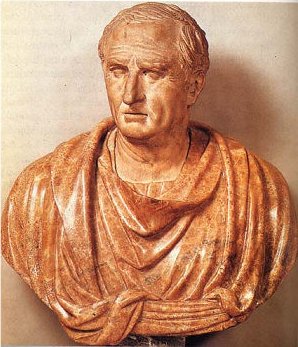Cicero claims that the earth is divided into strips. The two furthest strips, which are on both sides of the earth and are located below the poles of the sky, are covered in snow - the people sit between the strip of fire and the strip of ice.
Haim Mazar

Marcus Tullius Cicero, the Roman statesman and writer who lived between 43-106 BC, in his work "Scipio's Dream" (this is the final chapter of his book "On the Political Regime" written in 54 BC) refers to geographical and climatic aspects of the earth.
Cicero claims that the earth is divided into strips. The two furthest strips that are on both sides of the earth and are located below the poles of the sky are covered with snow. The central strip which is the largest is scorched due to the heat of the sun and the other two strips are inhabited by people. In the southern strip, those who live there have their feet in front of Scipio's feet and have nothing to do with him. Scipio and his people live in the northern strip and northern winds blow there.
This description raises quite a few questions because it goes beyond what was known in Cicero's day about the Earth. There is an explicit reference to the poles here. Where did Cicero get this knowledge from? The accepted ways in ancient times to reach different places were by land and by sea and were used in the framework of migrations of peoples, conquest campaigns and economic, social and military ties between countries. The duration of these journeys to long destinations can last for weeks and months, which requires heavy logistical assessments before setting off. If the journey was conducted as part of the migration of peoples, the logistical problems would have been tried to be solved as soon as they arose. However, if the trip was planned, the logistical assessment was an organic part of the preparations for the trip. When it comes to the poles, the distances that must be covered are greater, far beyond the centers of settlements known in Cicero's day. With the means that were common in his day, such journeys could last more than a year.
One should pay attention to the fact that in Cicero's description there is no evidence of a short-term presence of ice at the poles. The ice is frost ice, which means whoever got there stayed there for long periods of time. What measures did they use to survive in such extreme conditions? If indeed the journeys to the poles were planned, it is likely that only some of those who went returned safe and sound and most likely they would have been treated as heroes and they would have been given grand receptions. There is no evidence for this in the scriptures nor in the knowledge passed down from father to son, as is the way of oral literature.
Geographically, the South Pole is further away from Rome than the North Pole, which heightens the depth of questioning regarding this kind of knowledge in Cicero's time. If part of the journey to the North Pole is overland, then to the South Pole the entire journey is by sea. For such a long sea voyage, very large ships must be built, far beyond what was built in Rome. The duration of the journey should have been particularly long, several years, not to mention the financial expenses involved. Considering that the southern sky was unknown, navigation by stars becomes especially problematic. Today, ships reaching the poles must be equipped with appropriate equipment for breaking the ice that covers the oceans at the poles, a technology that was unknown to the Romans.
Cicero points out that the other side of the country is inhabited and that there is no connection with the local residents. And here another question arises. If there is no connection with the other side of the country, how did Cicero know about it? If these people or some of them knew the South Pole how did they do it? And if there is no connection with them, they are not able to transfer this knowledge to the Darya of Europe or India, with which the West already had connections, even if they were of a loose nature (see the travels of Alexander the Great in the direction of India).
Another figure to pay attention to is the location of the poles. According to Cicero's description, the ice regions are below the poles of the firmament. This is an accurate description whose knowledge is only possible by looking from a high altitude and for that a pilot is needed. It is hard to believe that Cicero had a pilot's license, let alone a plane that could take him there.
From the character of Cicero as depicted in his writings and the testimony of his contemporaries, it is hard to believe that this knowledge is nothing but a successful guess as to the geography of the earth. A possibility that Min deserves to be considered is that he had a literary source that was lost over the generations and that refers to much older periods that had technological capabilities far beyond the engineering skills of Rome. Delving into the treasure of Cicero's scientific knowledge and re-examining the sciences in Greece can open the door to new studies about the past of history, and quite a few surprises are likely to be expected.
